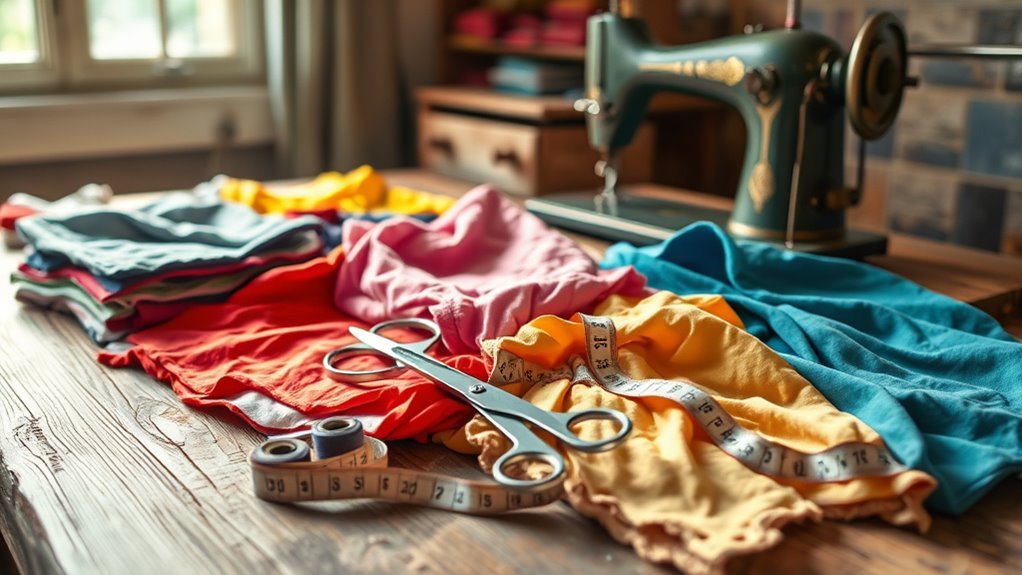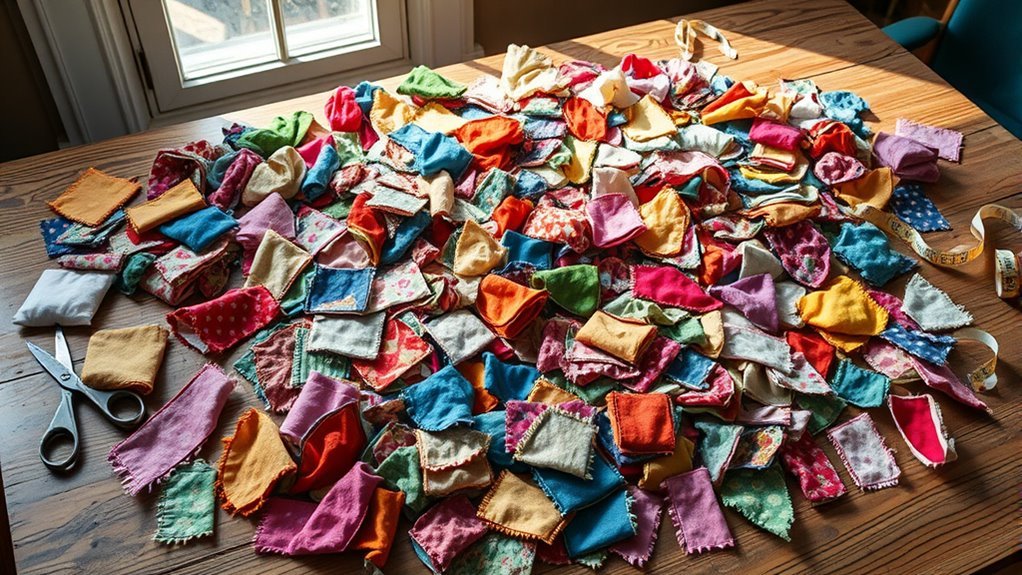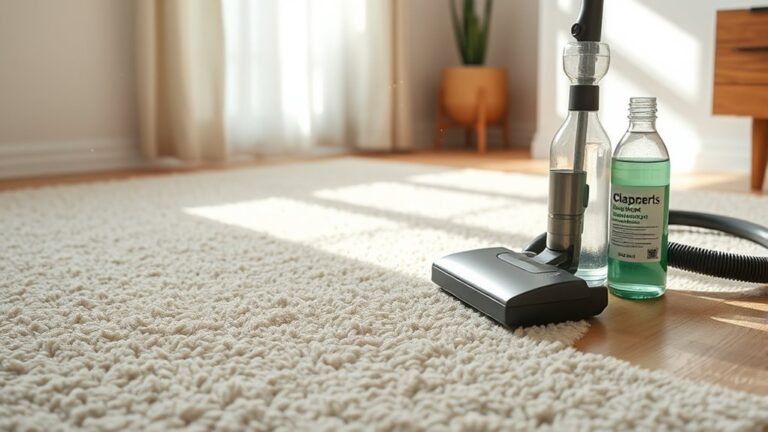How to Upcycle Old Clothes Into Cleaning Rags
You can easily upcycle old clothes into cleaning rags by choosing durable natural fabrics like cotton or linen, washing them thoroughly, and cutting them into useful sizes—small squares for tight spots or larger pieces for bigger messes. Use sharp scissors for clean cuts and consider reinforcing edges if needed. Store rags in breathable containers to keep them fresh. If you want to maximize their lifespan and know the best uses for each rag type, keep exploring these tips.
Choosing the Right Clothes for Upcycling

When selecting clothes to upcycle into cleaning rags, you’ll want to focus on fabrics that are both durable and absorbent. Choosing materials with the right fabric characteristics guarantees your rags will stand up to repeated use without falling apart. Natural fibers like cotton and linen are great choices because they soak up spills and grime efficiently. Avoid delicate fabrics or those with synthetic blends that resist water absorption or tear easily. Clothing durability matters most since your rag needs to withstand scrubbing and frequent washing. Look for old t-shirts, flannel shirts, or sturdy towels that have lost their style but not their strength. By picking wisely, you gain freedom from disposable cloths and craft cleaning tools that last, all while reducing waste.
Preparing Your Clothes for Transformation
Before you start cutting, make certain to sort your clothes by fabric type to guarantee the best cleaning results. You’ll also want to wash and dry them thoroughly to remove any dirt or residues. Taking these steps will prepare your materials perfectly for transformation into useful rags.
Sorting Fabric Types
Although upcycling old clothes into cleaning rags is a creative way to reduce waste, you’ll need to sort your fabric types carefully to get the best results. Not all fabrics are created equal, so consider fabric durability and color considerations before cutting into your clothes. Durable fabrics like cotton and denim work best for tough cleaning jobs, while delicate materials might fall apart quickly. Also, keep in mind that darker colors can hide stains better, making them ideal for rag use.
Here’s how to sort:
- Separate sturdy fabrics for scrubbing and heavy-duty tasks
- Group softer materials for light dusting and polishing
- Avoid mixing bright colors with whites to prevent color transfer
Sorting wisely guarantees your rags last longer and clean more effectively.
Washing and Drying
Washing and drying your old clothes properly is the essential next step to guarantee your cleaning rags are fresh, stain-free, and ready for use. You want to use washing techniques that remove dirt without damaging fabric fibers. Choose gentle cycles and mild detergents to keep materials soft. When it comes to drying methods, air-drying preserves fabric integrity, but using low-heat in a dryer speeds up the process without shrinking your rags.
| Washing Techniques | Drying Methods |
|---|---|
| Gentle cycle | Air-drying |
| Mild detergent | Low-heat dryer |
| Separate by fabric type | Avoid high heat |
These simple steps free you from harsh chemicals and help you create eco-friendly, durable cleaning rags.
Tools and Materials Needed

To get started with upcycling old clothes into cleaning rags, you’ll need a few basic tools and materials. Having the right gear makes the process smoother and more enjoyable. Your essential tools include a sharp pair of fabric scissors for clean cuts without fraying, a ruler or measuring tape to size your rags accurately, and a sewing needle with thread for quick fixes if needed.
Here’s a quick list to keep handy:
- Fabric scissors for precise, effortless cutting
- Measuring tape or ruler for consistent rag sizes
- Needle and thread for reinforcing edges if necessary
With just these essentials, you’re free to transform worn clothes into practical cleaning helpers, reducing waste and embracing a sustainable lifestyle.
Cutting Techniques for Different Fabric Types
When cutting cotton fabrics, make sure your scissors are sharp to get clean edges without fraying. For delicate materials, take extra care by trimming slowly and using smaller, precise cuts to avoid damage. Adjusting your technique based on the fabric will help you create durable, effective cleaning rags.
Cutting Cotton Fabrics
Although cutting cotton fabrics may seem straightforward, using the right techniques can make your upcycling project much easier and more effective. You want clean, even edges that won’t fray quickly, so choosing the right tools and approach is key. Always reach for sharp fabric scissors—they glide through cotton smoothly, saving you time and effort. Here are some cutting techniques to keep in mind:
- Lay your fabric flat on a hard surface to avoid shifting while you cut.
- Use long, steady cuts rather than short snips to maintain straight lines.
- Mark your cutting lines with tailor’s chalk or washable fabric markers for precision.
With these tips, you’ll enjoy freedom and confidence transforming old cotton clothes into practical cleaning rags.
Trimming Delicate Materials
Since delicate fabrics like silk or lace can easily snag or fray, you’ll want to adjust your cutting techniques accordingly. When trimming delicate fabrics, use sharp fabric scissors to guarantee clean cuts without pulling the fibers. Avoid using dull blades that can cause jagged edges or damage. Lay the fabric flat on a smooth surface and gently pin it to prevent shifting. If possible, cut with a single smooth motion rather than short snips to minimize stress on the material. For extra protection, consider placing tissue paper under the fabric while cutting—this helps stabilize the fibers. These trimming techniques keep delicate fabrics intact, letting you confidently transform them into effective cleaning rags without sacrificing their structure or softness. Embrace freedom by handling delicate materials with care and precision.
Creating Different Sizes and Shapes of Rags

To make the most out of your old clothes, you’ll want to cut them into various sizes and shapes that suit different cleaning tasks. Playing with rag dimensions and shape variations lets you customize each rag’s purpose, giving you freedom to tackle anything from delicate dusting to heavy scrubbing. Here’s how you can diversify your rag collection:
Customize your cleaning rags by cutting old clothes into varied sizes and shapes for every task.
- Small squares (around 6×6 inches) for tight spots and electronics
- Medium rectangles (8×12 inches) perfect for general surfaces and windows
- Larger irregular shapes for floors or bigger messes
Tips for Removing Stains Before Upcycling
Before you start cutting your old clothes into rags, it’s important to remove any stubborn stains that might transfer during cleaning. You want your rags to be fresh and free from unwanted marks, so applying effective stain removal techniques is key. Start by identifying the stain type and choose a suitable remover—like baking soda for grease or vinegar for ink. Gently treat the spots without harsh scrubbing to protect fabric fibers. Always check the garment’s care label to avoid damage and maintain fabric quality. Let the treated fabric air dry completely before cutting it into rags. By mastering these stain removal techniques and practicing good fabric care, you’ll guarantee your upcycled rags are both functional and long-lasting, giving you freedom from waste and extra cleaning hassle.
How to Sew or Secure Edges if Needed
Although many old clothes fray easily when cut, you can keep your cleaning rags intact by sewing or securing the edges. This small step guarantees your rags last longer and don’t unravel during use. You don’t need to be a pro; simple sewing techniques can do the trick. Here are some easy ways to secure edges:
Prevent fraying by sewing or securing old clothes edges to make durable, long-lasting cleaning rags easily.
- Use a basic running stitch around the perimeter to prevent fraying.
- Try a zigzag stitch if you have a sewing machine—it’s quick and effective.
- If sewing isn’t your thing, fabric glue or iron-on hemming tape works just as well.
Best Uses for Different Types of Upcycled Rags
When you’re repurposing old clothes into cleaning rags, knowing which fabric works best for each task can make your efforts much more efficient. For scrubbing tough stains, sturdy cotton or denim rags are your go-to—they handle grit without falling apart. Soft fabrics like old t-shirts are perfect for dusting or wiping delicate surfaces, avoiding scratches while soaking up messes. Microfiber blends, if you have them, excel at streak-free glass cleaning. Following these best practices not only boosts your cleaning game but also maximizes the eco friendly benefits of upcycling. By matching rag type to task, you reduce waste and save money while freeing yourself from single-use products. This mindful approach lets you clean smarter and live more sustainably, embracing freedom through thoughtful reuse.
Storing and Maintaining Your Cleaning Rags
Keeping your cleaning rags in good shape starts with proper storage and maintenance. When you upcycle old clothes into rags, you want them ready whenever you need freedom from dirt and grime. Smart storage solutions prevent your rags from getting musty or tangled.
Here’s how you can keep your rags fresh and functional:
- Store rags in a breathable container or mesh bag to avoid moisture buildup.
- Wash rags separately with mild detergent to maintain fabric quality and prevent transfer of residues.
- Air dry completely before storing to stop mildew and odors from developing.
Frequently Asked Questions
Can Upcycled Rags Be Used Safely on Electronics?
You can definitely use upcycled rags on your electronics, but you’ve got to follow some safety precautions. Make sure the rag is clean, lint-free, and dry to avoid damaging screens or internal components. Avoid harsh chemicals; instead, use gentle cleaners suited for electronics maintenance. This way, you keep your devices safe while embracing freedom from waste and extra expenses. Just take care, and your gear will thank you!
How Long Do Upcycled Cleaning Rags Typically Last?
Think of your cleaning rags as trusty sidekicks on your freedom journey—their longevity depends on material durability and how you treat them. Natural fibers like cotton tend to last longer, while synthetic ones might wear out quicker. Longevity factors include frequency of use and washing methods; gentle care extends their life. So, if you handle them well, your upcycled rags can serve you faithfully for months, freeing you from constant replacements.
Are There Eco-Friendly Detergents Recommended for Washing Rags?
You’ll love using eco friendly brands like Seventh Generation or Ecover for washing your rags—they’re gentle on the environment and tough on grime. If you want to ditch traditional detergents altogether, try detergent alternatives like baking soda, white vinegar, or castile soap. These options give you freedom from harsh chemicals while keeping your cleaning rags fresh and effective. It’s all about choosing what feels right for you and the planet.
Can Children Help With Making Cleaning Rags Safely?
Did you know involving kids in chores boosts their responsibility by 70%? You can safely include children in making cleaning rags by following simple safety guidelines. Let them help with cutting soft fabrics using child-friendly scissors and sorting colors. Always supervise to prevent accidents. This child involvement not only teaches them valuable skills but also gives you the freedom to enjoy eco-friendly, hands-on family activities together.
What Are Some Creative Projects Besides Cleaning Using Old Clothes?
You can totally release your creativity with old clothes beyond cleaning! Think clothing art—transform scraps into unique wall hangings or patchwork quilts that express your style. Fabric jewelry is another cool idea; braid or twist fabric strips into bracelets, necklaces, or earrings that show off your free spirit. These projects let you break free from conventional uses, turning forgotten fabrics into bold, personal statements that celebrate your individuality and eco-conscious mindset.






